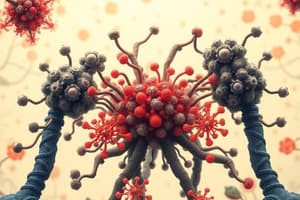Podcast
Questions and Answers
Which of the following represents the effective dose where 50% of the population responded effectively to the drug?
Which of the following represents the effective dose where 50% of the population responded effectively to the drug?
- TD50
- EC50 (correct)
- ID50
- LD50
What does the therapeutic index (TI) estimate in drug safety?
What does the therapeutic index (TI) estimate in drug safety?
- Ratio of effective dose to lethal dose
- Toxicity of the drug
- Effectiveness of the drug
- Ratio of toxic dose to effective dose (correct)
What type of dose response curve measures the efficacy of the drug?
What type of dose response curve measures the efficacy of the drug?
- Type 2
- Type B
- Type A
- Type 1 (correct)
What type of drug combination results in a greater effect than the sum of the two drugs individually?
What type of drug combination results in a greater effect than the sum of the two drugs individually?
Which of the following best describes pharmacodynamics?
Which of the following best describes pharmacodynamics?
Which of the following is NOT a drug target?
Which of the following is NOT a drug target?
What is the difference between agonists and antagonists?
What is the difference between agonists and antagonists?
What is the difference between competitive and non-competitive antagonists?
What is the difference between competitive and non-competitive antagonists?
Flashcards
EC50
EC50
The effective dose where 50% of the population responds to a drug.
Therapeutic Index (TI)
Therapeutic Index (TI)
The ratio of the toxic dose to the effective dose of a drug.
Type 1 Dose-Response Curve
Type 1 Dose-Response Curve
Measures the efficacy of a drug.
Synergistic Drug Combination
Synergistic Drug Combination
Signup and view all the flashcards
Pharmacodynamics
Pharmacodynamics
Signup and view all the flashcards
Non-drug target
Non-drug target
Signup and view all the flashcards
Agonist vs. Antagonist
Agonist vs. Antagonist
Signup and view all the flashcards
Competitive vs. Non-competitive Antagonists
Competitive vs. Non-competitive Antagonists
Signup and view all the flashcards
Study Notes
Pharmacodynamics: Understanding the Effects of Drugs on the Body
- Pharmacodynamics is the study of what a drug does to the body and how it interacts with drug targets.
- Drug targets are usually proteins such as receptors, ion channels, enzymes, or carriers.
- Drugs can function as agonists, mimicking the effects of endogenous molecules, or as antagonists, inhibiting the normal function of endogenous agonists.
- Competitive antagonists compete with agonists for the same binding site on receptors, while non-competitive antagonists bind to different sites and indirectly inhibit agonist binding.
- Inverse agonists inhibit the basal activity of receptors, even in the absence of endogenous agonists.
- The type 1 dose-response curve shows the relationship between drug dose and response efficacy, typically represented in a sigmoid log form.
- The maximal effect or Emax of a drug is its intrinsic activity, while maximal efficacy refers to the plateau of the dose-response curve.
- Full agonists have an intrinsic activity of 1 and can produce 100% of the desired effect, while partial agonists have an intrinsic activity between 0 and 1.
- Antagonists have an intrinsic activity of 0 and block the binding of endogenous agonists.
- Inverse agonists have a negative intrinsic activity and inhibit the basal activity of receptors.
- Affinity is the attractiveness of a drug to its receptor, while potency refers to the power of a drug at a specific concentration.
- Competitive antagonists shift the dose-response curve to the right, while non-competitive antagonists shift it down and decrease the maximum effect of the drug.
- Type 2 dose-response curves consider the number of subjects responding to a drug and can show therapeutic, toxic, and lethal responses.
Studying That Suits You
Use AI to generate personalized quizzes and flashcards to suit your learning preferences.




